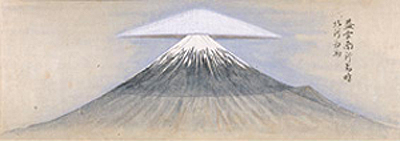|
|

|
100 Views of Mount Fuji

|
Mount Fuji is renowned worldwide as Japan's highest and most perfectly shaped mountain.
Serving as a potent metaphor in classical love poetry and revered since ancient times by mountain-climbing sects of the Shint�-Buddhist faith, Fuji has taken on many roles in pre-modern Japan.
100 Views of Mount Fuji explores a wide range of manifestations of this most inspirational of mountains as portrayed in 100 works by Japanese painters and print designers from the 17th to 20th century.
Drawn from the British Museum's collection, the exhibition begins with an examination of the more traditional Kan� and Tosa schools which served the military and court aristocracy respectively during the Edo period (1600-1868) and goes on to chart the emergence of influential new styles which were beginning to filter into Japan from China and Europe via the trading port of Nagasaki. Some Japanese artists, for example, looked to the Chinese scholar-painting (bunjinga) tradition as an escape from orthodoxy, while others championed Western-style naturalism as a more accurate means to record the landscape. By the end of the Edo period a dozen or more schools of painting were operating in parallel, catering to different classes and cultural groups.
The rapid growth of cities and the unique 'townsman' (ch�nin) culture of consumption and pleasure-seeking which accompanied it - particularly in Edo (modern Tokyo) - was also to prove highly influential and was mirrored in the paintings and colour woodblock prints of the Ukiyo-e ('Floating World') school. The main works of this section are those by Utagawa Hiroshige (1797-1858) and Katsushika Hokusai (1760-1849), including the complete set of colour prints from Hokusai's famous series Thirty-Six Views of Mt Fuji, 1830-33.
By the late 18th and 19th centuries urban artists of many schools were heading out from the cities in search of new landscape subjects and Mount Fuji presented a ready symbol both for 'Nature' and for the nascent ideology of Japan as a modern nation-state. The last section examines the way that new currents of empiricism and subjectivity have enabled Japanese artists of recent centuries such as Maekawa Sempan (1888-1960), Munakata Shik� (1903-75) and Hagiwara Hideo (b.1913) to project a surprisingly wide range of personal interpretations onto what was once regarded as such an eternal, unchanging symbol.
Mount Fuji claims a special place in the emotions and aesthetics of the Japanese people both in and outside Japan. This attachment, ingrained in the Japanese psyche for over a millennium, has driven those artists represented in the exhibition to express their personal relationship to the mountain from many angles and distances, in many moods and weathers.
A fully illustrated catalogue 100 Views of Mount Fuji by Timothy Clark, Assistant Keeper of Japanese Antiquities, British Museum accompanies the exhibition.
|
| On view: | 22 June to 25 August 2002
Art Gallery of New South Wales
Art Gallery Road, The Domain, Sydney Australia
www.artgallery.nsw.gov.au
| | Telephone: | (02) 9225 1744 or recorded information
(02) 9225 1790
| | Hours: | Daily 10am to 5pm | | Admission: | $6 adults/ $4 members/students/concessions | | Media Information and Interviews: | Claire Martin, Press Office
Telephone (02) 9225 1734
Email clairem@ag.nsw.gov.au
| Minamoto (no) sadayoshi
The summit of Mt Fuji in all Seasons 1818-1819
Handscroll; ink and colour on paper, 13.3 x 1341.1 cm
British Museum Collection
|
|
|